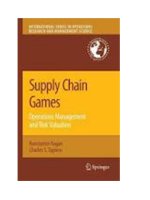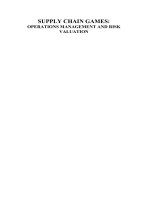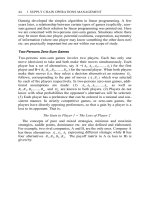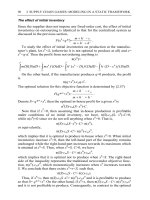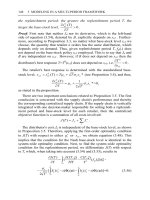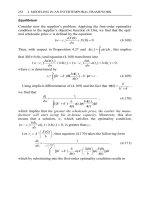Operations management heizer 6e sup11
Bạn đang xem bản rút gọn của tài liệu. Xem và tải ngay bản đầy đủ của tài liệu tại đây (346.28 KB, 36 trang )
Operations
Management
Supplement 11 –
E-Commerce and
Operations Management
PowerPoint presentation to accompany
Heizer/Render
Principles of Operations Management, 6e
Operations Management, 8e
© 2006
Prentice
Hall, Inc. Hall, Inc.
©
2006
Prentice
S11 – 1
Outline
The Internet
Electronic Commerce
E-Commerce Definitions
Economics Of E-Commerce
Product Design
Collaborative Project
Management
© 2006 Prentice Hall, Inc.
S11 – 2
Outline – Continued
E-Procurement
Online Catalogs
RFQs and Bid Packaging
Internet Outsourcing
Online Auctions
Inventory Tracking
© 2006 Prentice Hall, Inc.
S11 – 3
Outline – Continued
Inventory Reduction
Warehousing for E-Commerce
Just-in-Time Delivery for ECommerce
Scheduling And Logistics
Improvement
Coordinated Pickup and Delivery
Logistics Cost Reduction
© 2006 Prentice Hall, Inc.
S11 – 4
Learning Objectives
When you complete this supplement,
you should be able to:
Identify or Define:
E-commerce
B2B, B2C, C2C, C2B
Online catalogs
Outsourcing
E-procurement
© 2006 Prentice Hall, Inc.
S11 – 5
Learning Objectives
When you complete this supplement,
you should be able to:
Describe or Explain:
How E-commerce is changing the
supply chain
Online auctions
Internet trading exchanges
Inventory tracking
Pass-through warehouses
© 2006 Prentice Hall, Inc.
S11 – 6
The Internet
International computer network
Connects companies and people
around the world
Enables the integration of internal
information systems and enhanced
communications between organizations
Ties together global design,
manufacturing, delivery, sales, and
after-service
© 2006 Prentice Hall, Inc.
S11 – 7
The Internet
Reshaping how businesses think about
delivering value to customers
Prime benefits are speed and access
Important vehicle for change in
Operations Management
Intranets are internal networks not
available to external users
Growing daily with over 300 million
domains registered worldwide
© 2006 Prentice Hall, Inc.
S11 – 8
Electronic Commerce
E-commerce (or e-business) – the use of
the internet to buy and sell products and
services and exchange information
Low cost rapid exchanges
A whole new way of doing business
“… all about cycle time, speed, globalization,
enhanced productivity, reaching new
customers and sharing knowledge across
institutions for competitive advantage.”
Louis Gerstner
Former Chairman, IBM
© 2006 Prentice Hall, Inc.
S11 – 9
E-Commerce Definitions
Business-to-business (B2B) – Both sides
of the transaction are businesses, nonprofit organizations, or governments
Business-to-consumer (B2C) –
Transactions in which buyers are
individual consumers
Consumer-to-consumer (C2C) –
Consumers sell directly to each other
Consumer-to-business (C2B) –
Individuals sell services or goods to
businesses
© 2006 Prentice Hall, Inc.
S11 – 10
E-Commerce Transactions
Business
Consumer
Business
B2B
Global Health
Care Exchange,
Global Net
Xchange
B2C
Amazon, Dell,
Netgrocer.com
Consumer
C2B
Priceline,
Travelocity
C2C
eBay
Figure S11.1
© 2006 Prentice Hall, Inc.
S11 – 11
Economics of E-Commerce
Costs of information exchange are
dramatically reduced
Barriers to entry are lower
Time constraints almost disappear
Information and communication is
cheap and easy
© 2006 Prentice Hall, Inc.
S11 – 12
Types of Information
Product — drawings, specifications,
video, or simulation demonstrations,
prices
Production Processes — capacities,
commitments, product plans
Transportation — carrier availability,
lead times, costs
Inventory — inventory tracking, levels,
costs, and location
Table S11.1
© 2006 Prentice Hall, Inc.
S11 – 13
Types of Information
Suppliers — product catalog, quality
history, lead times, terms, and
conditions
Supply Chain Alliances — key contact,
partners’ roles and responsibilities,
schedules
Supply Chain Process and Performance
— process descriptions, performance
measures such as quality and delivery
Table S11.1
© 2006 Prentice Hall, Inc.
S11 – 14
Types of Information
Competitor — benchmarking, product
offerings, market share
Sales and Marketing — point of sale
(POS) data entry, promotions, pricing,
discounts
Customer — sales history and forecasts
Costs — market indexes, auction results
Table S11.1
© 2006 Prentice Hall, Inc.
S11 – 15
Benefits and Limitations
Benefits of E-Commerce
Improved, lower-cost information that
makes buyers and sellers more
knowledgeable has an inherent power to
drive down costs
Lower entry costs increase information
sharing
Available 24 hours a day, virtually any
place in the world, enabling convenient
transactions for those concerned
Table S11.2
© 2006 Prentice Hall, Inc.
S11 – 16
Benefits and Limitations
Availability expands the market for both
buyer and seller
Decreases the cost of creating,
processing, distributing, storing, and
retrieving paper-based information
Reduces the cost of communication
Richer communication than traditional
paper and telephone communication
because of video clips, voice, and
demonstrations
Table S11.2
© 2006 Prentice Hall, Inc.
S11 – 17
Benefits and Limitations
Fast delivery of digitized products such
as drawings, documents, and software
Increased flexibility of location. (That is,
it allows some processes to be located
anywhere electronic communications
can be established, and allows people
to shop and work from home.)
Table S11.2
© 2006 Prentice Hall, Inc.
S11 – 18
Benefits and Limitations
Limitations of E-Commerce
Lack of system security, reliability, and
standards
Lack of privacy
Some transactions are still rather slow
Integrating e-commerce software with
existing software and databases is still
a challenge
Table S11.2
© 2006 Prentice Hall, Inc.
S11 – 19
Benefits and Limitations
Lack of trust in (1) unknowns about the
integrity of those on the other end of a
transaction, (2) integrity of the
transaction itself, and (3) electronic
money that is only bits and bytes
Security and risk are major
factors in E-commerce
Table S11.2
© 2006 Prentice Hall, Inc.
S11 – 20
Product Design
Easily shared knowledge and
information allows quicker and lower
cost design cycles that can involve
participants in diverse locations
Product data can be managed over the
Internet
Engineering changes and configuration
management can be extended along the
supply chain
© 2006 Prentice Hall, Inc.
S11 – 21
Collaborative Project
Management
Project management software
allows for establishing intranet
sites for sharing documents and
maintaining status reports
Intranets can also be used for
document libraries
© 2006 Prentice Hall, Inc.
S11 – 22
E-Procurement
Purchasing or order release
communicated over the Internet
Online catalogs allow quicker cost
comparisons and bidding processes
Catalogs can be provided by
Vendors
Intermediaries
Buyers
© 2006 Prentice Hall, Inc.
S11 – 23
Online Catalogs
Vendor catalogs provide quick and
easy access to the entire product
line
Available to anyone with Internet
access
Quick and easy to customize and
adjust
Reduced paper trails reduce
purchasing costs
© 2006 Prentice Hall, Inc.
S11 – 24
Online Catalogs
Intermediary catalogs facilitate
buyers and sellers meeting
Buyers can find multiple sellers on
one site
Buyer-focused exchanges allow
groups of generally similar firms to
join together to buy in larger
quantities and more efficiently than
if they worked independently
© 2006 Prentice Hall, Inc.
S11 – 25


